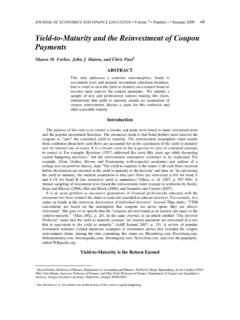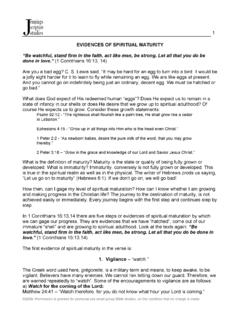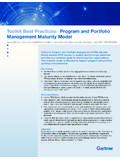Transcription of MATURITY IN HORSES AND MULES - Alberta
1 MATURITY IN HORSES AND MULESBy Marlene QuiringShould we be riding 2-year-old HORSES or 3 and 4-year-old MULES ? How do we know when a horse or mule is physically ready to be ridden? These are just some of the questions that were asked of Outfitter, Tim Barton of Banff, Alberta . Tim has spent over 35 years working with MULES and HORSES as a farrier, a packer, a guide and a teamster. He has a Bachelor of Science and Educational Degree and spent 20 years as an instructor of Equine and Comparative Anatomy at Olds College, Alberta , Canada. Tim owns and operates a remote mountain retreat ''The Outpost at Warden Rock'' bordering Banff National Park in the Alberta Rocky Mountains, west of Sundre. Over the years Tim has mainly used MULES for packing, but now exclusively uses them for driving, hauling in supplies and guests over the nine rocky miles from the Big Horn Staging area into the ''Outpost.
2 '' The following article reflects Tim's thoughts on MULES and HORSES and their using abilities relative to their mental and physical IS PHYSICAL MATURITY IMPORTANT?Tim advises that in order to access physical MATURITY in HORSES or MULES we need to understand their skeletal system. Bones grow in diameter and length and can continue to grow well past the typical age at which most HORSES and MULES are put into hard physical training. If extra weight is added to the skeletal frame at an early age, the epiphyseal or growth plates can become distorted and conformational problems can result. MULES , donkeys and several horse breeds such as the Arabian are typically slow to mature. Tim cautions that these slower maturing breeds should not be ridden until 3 or 4 and any hard riding should be avoided until they're at least 5 or 6.
3 These animals may look physically mature at age two or three but stressing their skeletal system before they are fully mature can have limiting consequences to their usefulness. In fact, some MULES have kept growing in height until eight or nine years of few horse breeds can handle light riding as late 2 yr. olds but most should not be started until at least 3 and again not ridden hard until 4 or 5. A horse's biggest growth year is between one and two years while slower breeds like the mule, have their biggest growth between two and three years. Unfortunately, owners or trainers often push HORSES at a young age with no regard to the horse's long term usefulness. Most English disciplines recognize that HORSES are not ready for intense training and competition until they are physically mature but traditionally, western riders are in a hurry to train and compete, most times to the detriment of the horse.
4 Tim on his Mule Josie MULES and breeds such as the Quarter horse tend towards a conformation where the front end is lower than the hind end. As they grow the back end will go up and then the front end will try and catch up and this pattern repeats itself until the animal is physically mature. As long as that animal is lower in the front end than the back end [downhill conformation], gravity will work to pull the saddle/rider into the low spot behind the animal's shoulders, making it difficult for the animal to perform to his best ability. Some may experience enough discomfort and pain that they exhibit dangerous behavior such as bolting or bucking to get away from the pain. MULES and HORSES are not designed to carry excess weight on their front end. Why is this? Tim states that the muscles responsible for lifting the front end of the animal are attached to the hip area.
5 Therefore, the farther the weight is carried from the hip, the greater the difficulty in carrying that weight. An animal with a low front end can only comfortably carry 100 to 120 lbs. while an animal with a more level conformation and correctly fitting tack, can usually comfortably carry someone twice that weight, day in and day out if need be. When an immature animal does not yet have a firm bone structure, a lot of the other features in the body have to start taking up the slack. If these animals are stressed too hard while they're still very immature, they can suffer tremendous damage to muscles, ligaments and tendons resulting in conformational features such as lordosis [sway-backed] or scoliosis [deviation of the spine]. Putting too much weight on the bone structure can tear ligaments that aren t strong enough to hold the spinal column together.
6 A ''cold-backed animal can be the result of having to carry weight when the animal was physically not ready. Other parts of the anatomy have had to take up the slack while the bones were still maturing and likely the animal has experienced discomfort or pain as a result. Carpal bones that make up the knee receive their blood supply through small ligaments that run from one bone to the next. This blood supply carries all the nutrients and material necessary for these bones to grow but the small size of the blood vessels limits this supply. As a result bones above and below the knee may mature more rapidly than the knee, resulting in what is often called open knees. Knees are considered ''closed'' when the growth of the knee has caught up. When you look at a side profile of the knee that still has an open knee, you will see an indention where the bones haven t grown rapidly enough.
7 Sometimes this feature happens in cross breeding through improper nicking of the genes. For example, breeding a Percheron mare to a light - boned jack can result in a mule with bones above and below the knee that belong to a Percheron and the knee bones from the jack. Hoof trimming can often change conformation by affecting the epiphyseal plates. Unbalanced trimming can crush the plates on one side and allow them to grow on the other. Adverse conformation can result when you don t properly maintain the hoof. When the plates grow unevenly, knock-knees or other conformational features that aren t conducive to real athletic ability, can be the result. An animal with poor conformation, whether accidental, inherited or caused by man, will be restricted in how much he can do versus another animal that is physically built to work and Mattie on trail to OutpostWHAT ABOUT MENTAL MATURITY ?
8 An animal is not ready to work until it is physically and mentally mature. If the animal starts hurting - with MULES in particular being self-preservers - their temperament can change. In Tim Barton s line of business, temperament is critical in the animals he uses and can be affected by what the animal has been exposed to. If they've been constantly subjected to pain, or overworked, their temperament will change. A mule or horse in pain is not a willing you're waiting for your horse or mule to mature, its a good idea to spend your time on ground work including getting them socialized, desensitized to scary things that they may encounter later, and generally building a good foundation from the ground up. This foundation will pay off once your animal is ready for saddle or and other slower maturing breeds need extra time to grow up mentally too.
9 Allowing this time pays off in the long run. HORSES can work up into their late 20's and MULES into their late 30's if they haven't been hurt as youngsters by overstraining them mentally or physically. Of course along with this goes good health care including good dental care. Tim believes that HORSES and MULES don't die as much from old age as they do bad teeth, thus rendering them unable to eat MUCH WEIGHT CAN THEY SAFELY CARRY?Tim cautions that you have to use common sense as far as how much weight an animal can carry. Some animals are maxed out at 150 lbs. of ''live'' weight, while others with better conformation and level, shorter, stronger backs can pack 250 lbs. of ''dead'' weight. However, they all have to be conditioned and in shape before you work them hard. You can have two animals that weigh 1400 lbs.
10 With similar conformation and one is able to carry several 100 lb. propane bottles without bothering it and the other simply can' common mistake that many people make is putting animals to work without getting them into shape first. For example, if you take an older fully mature animal for a 10-day trip into the mountains, you can break them down if they're not in shape. For sure you will hurt their back - people don't think about that but if you were to take on climbing a mountain without being in shape first, you will suffer, even more so if your boots are ill fitting and poorly designed for your feet. An animal that s out of shape and also forced to work with ill-fitting tack can suffer tremendously. Make sure that you give your animals enough exercise and work to get their backs in shape before you work them hard.








